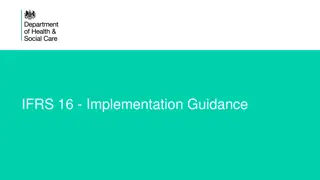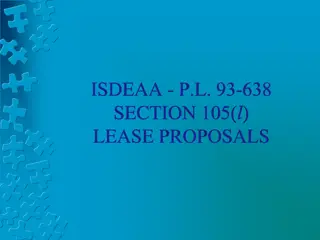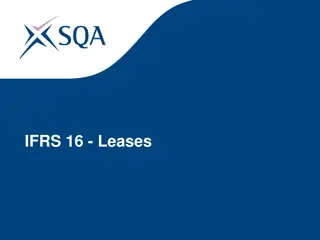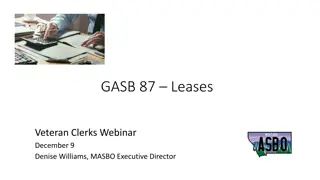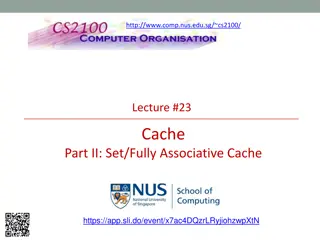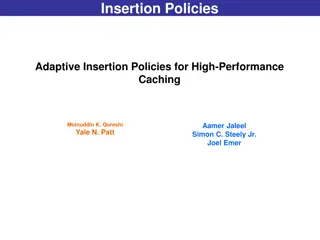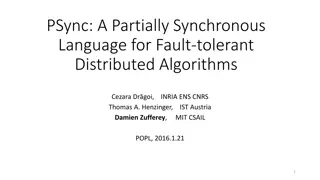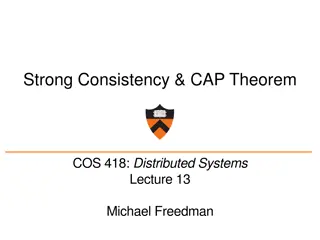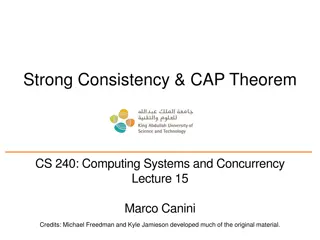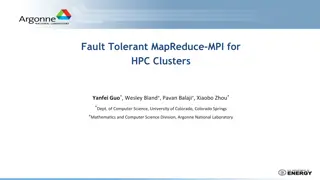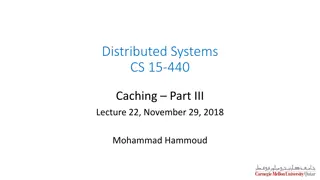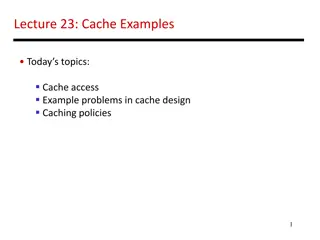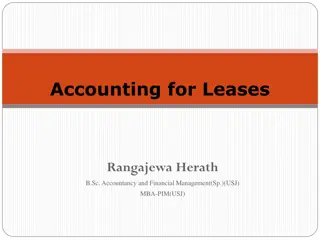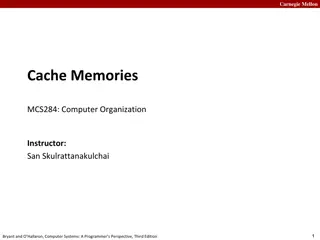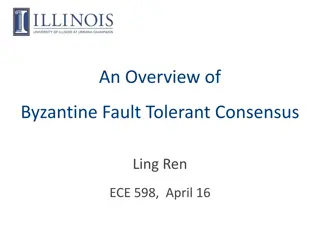Leases: Efficient Fault-Tolerant Mechanism for Distributed File Cache Consistency
Paper highlights the best mechanism for maintaining consistency in distributed systems, tolerating failures and network partitions. Leases grant control over writes to data, requiring approval from leaseholders. Examples illustrate lease granting and breaking scenarios. Leases offer advantages over NFS solutions in terms of rigor and cost-effectiveness.
Download Presentation

Please find below an Image/Link to download the presentation.
The content on the website is provided AS IS for your information and personal use only. It may not be sold, licensed, or shared on other websites without obtaining consent from the author.If you encounter any issues during the download, it is possible that the publisher has removed the file from their server.
You are allowed to download the files provided on this website for personal or commercial use, subject to the condition that they are used lawfully. All files are the property of their respective owners.
The content on the website is provided AS IS for your information and personal use only. It may not be sold, licensed, or shared on other websites without obtaining consent from the author.
E N D
Presentation Transcript
LKAS 17
ORIENTATION Objective Scope Definition Classification of Leases Finance Lease Operating Lease Finance Leases and Operating Leases Calculations Sale and lease back Disclosures
OBJECTIVE The objective of this Standard is to prescribe, for lessees and lessors, the appropriate accounting policies and disclosure to apply in relation to leases.
Where can this stand apply? Where shall not be applied?
DEFINITIONOFA LEASE
A lease is an agreement whereby the lessor conveys to the lessee in return for a payment or series of payments the right to use an asset for an agreed period Finance lease Operating lease
FINANCELEASES V OPERATINGLEASES Finance Lease Operating Lease A lease is a finance lease if it transfers substantially all the risks and rewards incident to ownership A lease is an operating lease if it does not transfer substantially all the risks and rewards incident to ownership Substance over Form
RISKS AND REWARDS INCIDENT TO OWNERSHIP Risks Rewards Losses from idle capacity Technological obsolescence Changes in value due to changing economic conditions etc. Expectation of service potential or profitable operation over the asset s economic life Gain from appreciation in value Realisation of a residual value etc.
FINANCELEASEOR OPERATINGLEASE? (4) Conclude on whether substantially all the risks and rewards have been transferred from the lessor to the lessee Renewal options (3) Determine the net present value (NPV) of the minimum lease payments Cancellation provisions (2) Determine the lease term (1) Identify the business purpose behind the lease and its economic impact together with the economic issues at the end of the lease term Rights and obligations at end of lease
FINANCE LEASE OR OPERATING LEASE? Examples of situations which would normally lead to a lease being classified as a finance lease: The lessor transfers ownership of the asset to the lessee at the end of the lease term The lessee has the option to purchase the asset at a price, which is expected to be sufficiently lower than the fair value at the date the option becomes exercisable such that, at the inception of the lease, it is reasonably certain that the option will be exercised
FINANCE LEASE OR OPERATING LEASE? Examples of situations which would normally lead to a lease being classified as a finance lease (cont d): The lease term is for the major part of the economic life of the asset even if title is not transferred The leased assets are of a specialised nature such that only the lessee can use them without major modifications being made The leased assets cannot be easily replaced At the inception of the lease, the present value of the minimum lease payments (MLP) amounts to at least substantially all of the fair value of the leased asset
FINANCE LEASE OR OPERATING LEASE? Other indicators which individually or in combination could also lead to a lease being classified as a finance lease: If the lessee can cancel the lease, the lessor s losses associated with the cancellation are borne by the lessee The lessee bears gains/losses from changes in the fair value of the residual The lessee has the ability to continue the lease for a secondary period at a rate which is substantially lower than market rate
ACCOUNTINGFOR FINANCE LEASE
FINANCE LEASE ACCOUNTINGBY LESSEE Substance of the transaction should be considered. At the beginning of the lease term, the lessee recognizes, The leased asset and The obligation to make lease payments as a liability The asset and liability are measured at the lower of The fair value of the asset The present value of the minimum lease payments
FINANCE LEASE ACCOUNTINGBY LESSEECONT.. Lease payments are split between finance charge and the repayment of the outstanding liability. The depreciation policy for assets held under finance leases should be consistent with that for owned assets. If the lessee will obtain ownership of the asset at the end of the lease, depreciation is made over the useful life of the asset. Otherwise the asset should be depreciated over the shorter of the lease term or the life of the asset.
DOUBLEENTRIESINTHEBOOKSOF THELESSEE FINANCE LEASE Recognize the asset Non-Current asset Lessor Lease rental repayment Lessor Cash/ Bank Annual Interest Interest Expense (P&L) Dr Lessor Dr Cr Dr Cr Cr
DOUBLEENTRIESINTHEBOOKSOF THELESSOR FINANCE LEASE Asset transferred Receivable Non-current asset For the lease installment received Cash/Bank Lessee For the interest Lessee Interest income Dr Cr Dr Cr Dr Cr
OPERATING LEASE
DEFINITION An operating lease is a lease other than finance lease Lease that does not transfer substantially all of the risks and rewards to the lessee. Lessee Lessor Right to use asset Asset
OPERATING LEASE ACCOUNTINGBY LESSEE / LESSOR Lessee Prepaid/accrued lease rental payable Lessor Leased asset Accrued/deferre d lease rental receivable Depreciation expense Lease rental income Statement of financial position Lease rental expense Statement of comprehensive income
ACCOUNTINGBY LESSEE An asset is not recognized Rental under operating lease are charged to the income statement on a straight line basis over the term of lease, unless another systematic and rational basis is more appropriate. Any difference between amount charged and amounts paid will be prepayments or accruals.
ACCOUNTINGBY LESSOR Lease income from operating leases shall be recognized in income on straight line basis over the lease term, Unless another systematic basis is more representative of the time pattern in which use benefit derived from the leased asset diminished. The depreciation policy for depreciable leased assets shall be consistent with the lessor s normal depreciation policy for similar assets and depreciation shall be calculated in accordance with LKAS 16.
DOUBLEENTRIESINTHEBOOKSOF THELESSEE OPERATING LEASE Lease rental repayment Rental expense Cash or accrued lease rental payable Cr Dr
DOUBLEENTRIESINTHEBOOKSOF THELESSOR OPERATING LEASE At the Beginning Leased asset Cash or creditor Dr Cr At the end of the year Depreciation expense Leased asset Cr Dr Cash or accrued lease rental Dr Lease rental income Cr
OPERATINGLEASE - EXAMPLE Example On 1 January 2014, X signs a 5-year lease for equipment The cost of the equipment was 30,000 Total lease payments are 20,000 (4,000/year) Unguaranteed residual value is 15,000 Economic life of equipment is 10 years Questions What are the journal entries to be recorded at 1 January 2014 and 31 December 2014? 26
OPERATINGLEASE - SOLUTION (LESSEE) No entry at 1 January 2014 27 At 31 December 2014: Dr Rental expense 4,000 Cr Cash or accrued lease rental payable 4,000
OPERATINGLEASE - SOLUTION (LESSOR) At 1 January 2014: 28 Dr Leased asset 30,000 Cr Cash or creditor 30,000 At 31 December 2014: Dr Depreciation expense 3,000 Cr Leased asset 3,000 Dr Cash or accrued lease rental 4,000 Cr Lease rental income 4,000
Samson PLC has purchased a machine on 01st of April 2014 under the terms of lease for 5 million for the period of 5 years at the rate of 12%. First payment coming at the end of the first year. The lease agreement specifies that Samson PLC gets to keep the machine at the end of the lease. Question Indicate the amortization schedule & calculate the appropriate amounts to be included in the financial statements of the lessee for the year ended 31st March 2015.
AMORTISATION SCHEDULE Opening Balance Closing Balance Year Installment Interest Capital 0 - - - - 5,000,000.00 1 5,000,000.00 1,387,115.00 600,000.00 787,115.00 4,212,885.00 2 4,212,885.00 1,387,115.00 505,546.20 881,568.80 3,331,316.20 3 3,331,316.20 1,387,115.00 399,757.94 987,357.06 2,343,959.14 4 2,343,959.14 1,387,115.00 281,275.10 1,105,839.90 1,238,119.24 5 1,238,119.24 1,387,115.00 148,574.31 1,238,119.24 - 6,935,575.00 1,935,153.55 5,000,000.00
LEASE SCHEDULE Gross Lease liability Opening balance as at 01st April 2014 Add : Lease obtained during the year Less : Settlements during the period Balance as at 31st March 2015 - 6,935,575 -1,387,115 5,548,460 Interests in Suspense Opening balance as at 01st April 2014 Add : Interest in suspense charge during the year Less : Charged to Income Statement Balance as at 31st March 2015 - 1,935,154 -600,000 1,335,154 LEASE OBLIGATION AS AT 31ST MARCH 2015 4,212,885
BALANCE SHEET CLASSIFICATION CURRENT PORTION Gross Lease liability INTERESTS IN SUSPENSE LEASE OBLIGATION ( Net Lease liability ) 1,387,115 -505,546 881,569 LONG TERM PORTION Gross Lease liability INTERESTS IN SUSPENSE LEASE OBLIGATION ( Net Lease Liability ) 3,331, 316 4,161,345 -829,607 TOTAL LEASE OBLIGATION AS AT 31ST MARCH 2015 4,212,885
SALEAND LEASEBACK TRANSACTIONS
DEFINITION Sale and leaseback transaction is an arrangement in which one party sells a property to a buyer and the buyer immediately leases the property back to the seller.
Advantages of sale and leaseback Releases cash tied up in assets already owned Cheaper than borrowing money All the risks & rewards of the asset are transferred to the buyer The lessee can still use the asset No extra time required for re-training on new equipment Disadvantages of sale and leaseback Loss control over the asset In the long term it is more expensive
Accounting Treatment for Sales & Leaseback Transactions Sale & Leaseback Under Finance Lease If a sale and leaseback transaction results in a finance lease, any excess of sales proceeds over the carrying amount shall not be immediately recognized as income by a seller-lessee. Instead, it shall be deferred and amortized over the lease term.
Sale & Leaseback Under Operating Lease Any profit or loss arising is accounted for as follows If the transaction is; at market rate Future lease rentals below market rate At fair value Below fair value Future lease rentals Recognize immediately Recognize immediately Deferred & amortized over the lease period Excess over fair value should be deferred & amortized over the lease period Above fair value
KEY DISCLOSURES FINANCE LEASES (LESSEES) Requirements of SLFRS 7 Net carrying amount at the end of the reporting period A reconciliation between the total of future minimum lease payments Contingent rents recognized as an expense in the period General description of the lessee s material leasing arrangements Requirements for disclosure in accordance with LKAS 16, LKAS 36, LKAS 38, LKAS 40 and LKAS 41 apply to lessees for assets leased under finance leases
KEY DISCLOSURES OPERATING LEASES (LESSEES) Total of future minimum lease payments Lease and sublease payments recognized as an expense in the period General description of the lessee s significant leasing arrangements
KEY DISCLOSURES FINANCE LEASES (LESSORS) Requirements in SLFRS 7 Reconciliation between the gross investment in the lease at the end of the reporting period Unearned finance income Unguaranteed residual values accruing to the benefit of the lessor
KEY DISCLOSURES FINANCE LEASES (LESSORS) Accumulated allowance for uncollectible minimum lease payments receivable Contingent rents recognized as income in the period General description of the lessor s material leasing arrangements.
KEY DISCLOSURESOPERATING LEASES (LESSORS) Requirements of SLFRS 7 Future minimum lease payments under non- cancellable operating leases Total contingent rents recognized as income in the period General description of the lessor s leasing arrangements disclosure requirements in LKAS 16, LKAS 36, LKAS 38, LKAS 40 and LKAS 41 apply to lessors for assets provided under operating leases



